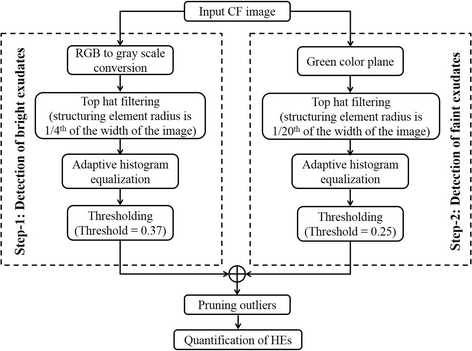Semi-automated quantification of hard exudates in colour fundus photographs diagnosed with diabetic retinopathy
- PMID: 28931389
- PMCID: PMC5607622
- DOI: 10.1186/s12886-017-0563-7
Semi-automated quantification of hard exudates in colour fundus photographs diagnosed with diabetic retinopathy
Abstract
Background: Hard exudates (HEs) are the classical sign of diabetic retinopathy (DR) which is one of the leading causes of blindness, especially in developing countries. Accordingly, disease screening involves examining HEs qualitatively using fundus camera. However, for monitoring the treatment response, quantification of HEs becomes crucial and hence clinicians now seek to measure the area of HEs in the digital colour fundus (CF) photographs. Against this backdrop, we proposed an algorithm to quantify HEs using CF images and compare with previously reported technique using ImageJ.
Methods: CF photographs of 30 eyes (20 patients) with diabetic macular edema were obtained. A robust semi-automated algorithm was developed to quantify area covered by HEs. In particular, the proposed algorithm, a two pronged methodology, involved performing top-hat filtering, second order statistical filtering, and thresholding of the colour fundus images. Subsequently, two masked observers performed HEs measurements using previously reported ImageJ-based protocol and compared with those obtained through proposed method. Intra and inter-observer grading was performed for determining percentage area of HEs identified by the individual algorithm.
Results: Of the 30 subjects, 21 were males and 9 were females with a mean age of the 50.25 ± 7.80 years (range 33-66 years). The correlation between the two measurements of semi-automated and ImageJ were 0.99 and 0.99 respectively. Previously reported method detected only 0-30% of the HEs area in 9 images, 30-60% in 12 images and 60-90% in remaining images, and more than 90% in none. In contrast, proposed method, detected 60-90% of the HEs area in 13 images and 90-100% in remaining 17 images.
Conclusion: Proposed method semi-automated algorithm achieved acceptable accuracy, qualitatively and quantitatively, on a heterogeneous dataset. Further, quantitative analysis performed based on intra- and inter-observer grading showed that proposed methodology detects HEs more accurately than previously reported ImageJ-based technique. In particular, we proposed algorithm detect faint HEs also as opposed to the earlier method.
Keywords: Automated quantification; Colour fundus photography; Diabetic retinopathy; Disease management; Hard exudates; ImageJ; Macular edema.
Conflict of interest statement
Ethics approval and consent to participate
Approval from Intuitional Review Board, L V Prasad Eye Institute, Hyderabad, India. The study was conducted in accordance with the tenets of the Declaration of Helsinki.
Consent for publication
None
Competing interests
The authors declare that they have no competing interests.
Publisher’s Note
Springer Nature remains neutral with regard to jurisdictional claims in published maps and institutional affiliations.
Figures







Similar articles
-
Quantitative evaluation of hard exudates in diabetic macular edema after short-term intravitreal triamcinolone, dexamethasone implant or bevacizumab injections.BMC Ophthalmol. 2017 Oct 3;17(1):182. doi: 10.1186/s12886-017-0578-0. BMC Ophthalmol. 2017. PMID: 28974211 Free PMC article.
-
New Method of Quantitative Analysis of Hard Exudate Using Optical Coherence Tomography: Application in Diabetic Macular Edema.Korean J Ophthalmol. 2019 Oct;33(5):399-405. doi: 10.3341/kjo.2019.0049. Korean J Ophthalmol. 2019. PMID: 31612649 Free PMC article.
-
Distribution of intraretinal exudates in diabetic macular edema during anti-vascular endothelial growth factor therapy observed by spectral domain optical coherence tomography and fundus photography.Retina. 2014 Dec;34(12):2407-15. doi: 10.1097/IAE.0000000000000250. Retina. 2014. PMID: 25062440
-
Application of different imaging modalities for diagnosis of Diabetic Macular Edema: A review.Comput Biol Med. 2015 Nov 1;66:295-315. doi: 10.1016/j.compbiomed.2015.09.012. Epub 2015 Sep 25. Comput Biol Med. 2015. PMID: 26453760 Review.
-
A review on exudates detection methods for diabetic retinopathy.Biomed Pharmacother. 2018 Jan;97:1454-1460. doi: 10.1016/j.biopha.2017.11.009. Epub 2017 Dec 14. Biomed Pharmacother. 2018. PMID: 29156536 Review.
Cited by
-
Artificial intelligence for diabetic retinopathy in low-income and middle-income countries: a scoping review.BMJ Open Diabetes Res Care. 2023 Aug;11(4):e003424. doi: 10.1136/bmjdrc-2023-003424. BMJ Open Diabetes Res Care. 2023. PMID: 37532460 Free PMC article.
-
An Approach to Automatic Hard Exudate Detection in Retina Color Images by a Telemedicine System Based on the d-Eye Sensor and Image Processing Algorithms.Sensors (Basel). 2019 Feb 8;19(3):695. doi: 10.3390/s19030695. Sensors (Basel). 2019. PMID: 30744032 Free PMC article.
-
Quantification of Microvascular Lesions in the Central Retinal Field: Could It Predict the Severity of Diabetic Retinopathy?J Clin Med. 2023 Jun 9;12(12):3948. doi: 10.3390/jcm12123948. J Clin Med. 2023. PMID: 37373641 Free PMC article.
-
Retinal Vascular Imaging in Vascular Cognitive Impairment: Current and Future Perspectives.J Exp Neurosci. 2018 Sep 20;12:1179069518801291. doi: 10.1177/1179069518801291. eCollection 2018. J Exp Neurosci. 2018. PMID: 30262988 Free PMC article. Review.
-
A deep learning approach to hard exudates detection and disorganization of retinal inner layers identification on OCT images.Sci Rep. 2024 Jul 19;14(1):16652. doi: 10.1038/s41598-024-63844-9. Sci Rep. 2024. PMID: 39030181 Free PMC article.
References
-
- Yamaguchi M, Nakao S, Kaizu Y, Kobayashi Y, Nakama T, Arima M, Yoshida S, Oshima Y, Takeda A, Ikeda Y. High-resolution imaging by adaptive optics scanning laser ophthalmoscopy reveals two morphologically distinct types of retinal hard exudates. Sci Rep. 2016;6:33574. doi: 10.1038/srep33574. - DOI - PMC - PubMed
Publication types
MeSH terms
LinkOut - more resources
Full Text Sources
Other Literature Sources
Medical

